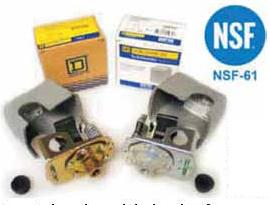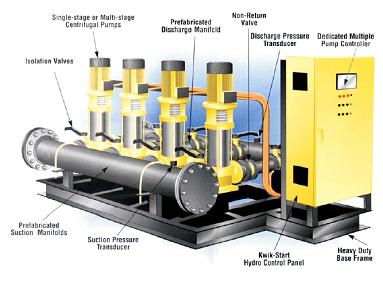An evolution in pressure-sensing technologies and the standards that regulate them help prevent equipment failure.
Pressure sensing is an age-old technology that is an integral part of water management. It is frequently associated with residential water supplies but is also an integral part of most pumping applications—including commercial building, irrigation and numerous industrial applications.
Pressure Sensor
The basic function of the pressure sensor revolves around monitoring or controlling pressure in water systems. Sensors help prevent over-pressure and over-cycling that can lead to premature equipment failure in pumping applications. This sensor technology has evolved, and now solid state pressure sensors monitor and maintain constant pressure. When these sensors are used in conjunction with variable frequency drives (VFDs), they can help optimize motor efficiency and reduce the energy consumption of pumping systems.
For more than half a century, pumping applications have opted for electromechanical technology, but like many other technologies, the market dynamics continuously evolve and change. Products and solutions also experience change—both legislatively and application driven.
The pressure switch has been the backbone of the domestic well market for ages. Whether used on jet pumps, where the switch is typically mounted to the pump itself, or on submersible pumps, where the switch is surface mounted separately (see Figure 1), a combination of new legislation and standards evolution has caused major manufacturers to update/upgrade and offer safer and more environmentally-friendly products.
 |  |
| Figure 1. The mounting locations of pressure sensors on different pump types |
A Safer Switch
On the legislative side, growing concern with lead contamination has created requirements for a dramatic reduction in lead for all water system components that may come in contact with drinking water—the pressure switch included. An example is the California Assembly Bill 1953 that requires the weighted average lead content of wetted surface areas for pipes, fittings and fixtures to be not more than 0.25 percent.
In addition, the U.S. Senate recently passed legislation lowering the federal “lead-free” standard for newly installed pipes and plumbing fixtures. S. 3874, also known as the “Get the Lead Out” bill, specifies that plumbing fixtures may contain no more than a weighted average of 0.25 percent lead, bringing the new federal standards in line with the more stringent levels previously established by California. The current federal lead-free standard is 8 percent. New certifications will continue as manufacturers strive to certify products to the more stringent federal requirements.
In the area of standards, the Reduction of Hazardous Substances (RoHS) directive is focused on creating more environmentally-friendly products. One example of adaptation is a Chromate 3 corrosion resistant plating which is more environmentally friendly. It covers all metal parts, protecting the switch’s key mechanical components and can be identified by its silver color.
 |
| Figure 2. Chromate 3 plated switch on the right versus an uncoated switch on the left |
Another good example would be the move from a polyester contact block to one made of nylon. This provides a solution that is stronger and less susceptible to breakage, has a superior comparative arc tracking index, with a material that meets a higher degree of RoHS compliance.
Of course when any manufacturer is driven to make product enhancements, additional factors are often taken into consideration. For example
Enhanced grounding security from indentions that were added just above the grounding screws to provide better retention of the grounding wire, resulting in greater reliability and improved wiring.
Cable entry plugs or “Bug plugs” were developed and are provided with every switch to keep bugs, debris and other contaminants out of the switch.
Pressure Transmitters
Pressure transmitters are often a necessary part of any pumping system—because they provide a reliable method to control and/or monitor the system pressure—to maintain constant pressure. Pressure transmitters (or transducers) are electronic devices with analog output. Going beyond the function of the pressure switch, pressure transmitters transform a change of pressure into an analog signal. The transmitter can easily interface with common automation systems, whether they are programmable logic controllers (PLC) or VFDs, to achieve pressure regulation.
Key applications for pressure transmitters are found in the building, industrial, water/wastewater, irrigation and residential markets as end users increasingly understand the benefits of constant pressure systems. The advantages for end users include the elimination of annoying pressure fluctuations, an increase in motor life by reducing the number of damaging on/off cycles and the use of smaller pressure tanks that can save both space and money. Perhaps most important, they reduce energy consumption, as the motor will often run at a reduced speed.
Looking at the architecture of such a system (see Figure 4), multiple pump systems are often employed to both optimize pumping operation based on varying loads, as well as prolong pump life. Also, pressure transducers are located on both the suction and discharge to maintain constant pressure.
 |
| Figure 4. Pump system with pressure transmitters |
The Sensing Evolution
A tremendous evolution in pressure-sensing technologies and the standards which regulate them has occurred. Keeping up to date, whether a manufacturer or consumer, to insure that evolving codes are met is important, and of course clean, safe drinking water is a priority for all.

